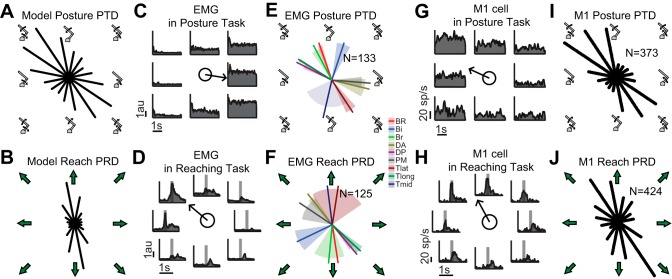Fig. 3.
Preferred torque and reaching directions. A: polar histogram of each network unit's PTD in 1 network. Angles are in torque space (shoulder torque x-axis, elbow torque y-axis). B: polar histogram of each network unit's PRD in 1 network. C: exemplar activity of pectoralis major in 8 shoulder/elbow loaded conditions (unloaded condition not shown) during the last 3 s of in the posture task. Arrow in the center denotes the muscle's PTD (351°). au, Arbitrary unit. D: exemplar activity of pectoralis major around reach onset while reaching to the 8 targets (set iii in Fig. 1B). Arrow in the center denotes the muscle's PRD (140°). E and F: averages of the PTD (E) and PRD (F) of all muscle samples are shown with 95% confidence intervals as shaded areas around each line. BR, brachioradialis; Bi, biceps; Br, brachialis; DA, anterior deltoid; DP, posterior deltoid; PM, pectoralis major; Tlat, lateral triceps; Tlong, long head triceps; Tmid, middle triceps. G: activity of an exemplar primary motor cortex (M1) neuron in the 8 shoulder/elbow loaded conditions (unloaded condition not shown) during the last 3 s of in the posture task. Arrow in the center denotes the neuron's PTD (155°). H: activity of an exemplar M1 neuron around reach onset while reaching to the 8 targets (set iii in Fig. 1B). Arrow in the center denotes the neuron's PRD (119°). I and J: polar histograms of all significant PTDs and PRDs across the population of recorded M1 neurons.

